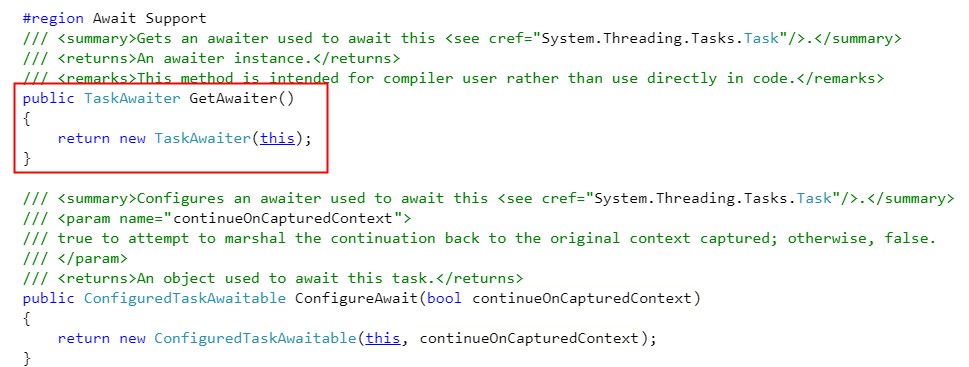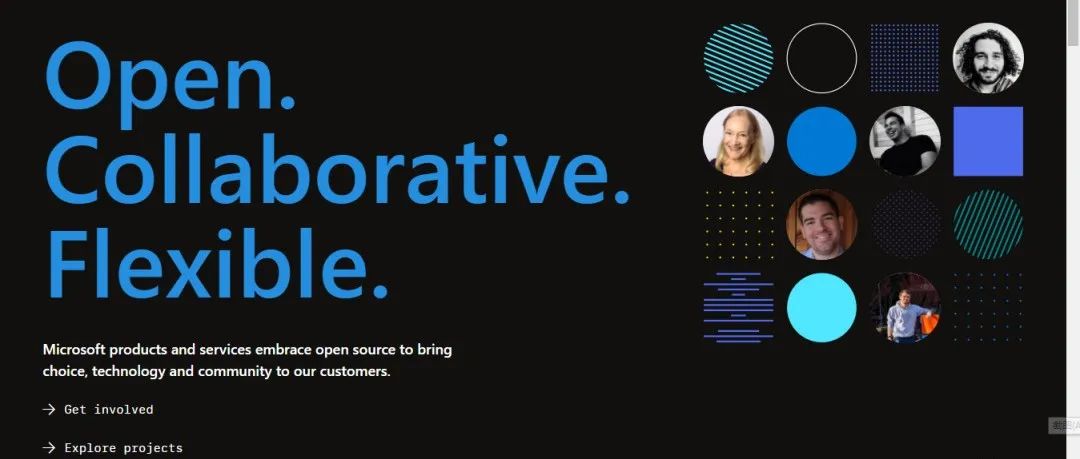面试官:还不了解Async/Await 语法糖?
转自:xboo cnblogs.com/bobsprite/p/11211549.html
提起.NET中的async/await,相信很多人第一反应都会是异步编程,其本质是语法糖、但继续追查下去,既然是语法糖,那么经过编译之后,真正的代码是什么样的,如何执行的?
带着这些疑问,通过网上资料的查询,可以了解到编译之后,是通过实现 IAsyncStateMachine 的一个状态机来实现的,博客园里大神Jeffcky 已经说得很清楚了
传送门:
https://www.cnblogs.com/CreateMyself/p/5983208.html
上述知识对我们理解 async/await 非常重要,但不是本文讨论的侧重点,触发笔者写这篇文章的初衷是:
一、只有Task可以被await吗,await之后就一定是异步执行吗?
答案当然不是,google了一圈后发现,当一个类可以被await,必须满足以下条件:
它必须包含 GetAwaiter() 方法(实例方法或者扩展方法) // 手动划重点:扩展方法,聪明的你是不是立马有些思想火花
GetAwaiter() 返回awatier实例,并且这个实例包含如下条件:
必须实现 INotifyCompletion 或者 ICriticalNotifyCompletion 接口
必须包含 IsCompleted 公共属性
必须包含 GetResult() 方法,返回void或者其他返回值
上述条件中INotifyCompletion 接口信息如下:
//
// 摘要:
//Represents an operation that schedules continuations when it completes.
public interface INotifyCompletion
{
//
// 摘要:
// Schedules the continuation action that's invoked when the instance completes.
//
// 参数:
// continuation:
// The action to invoke when the operation completes.
//
// 异常:
// T:System.ArgumentNullException:
// The continuation argument is null (Nothing in Visual Basic).
void OnCompleted(Action continuation);
}重点上述对于参数 continuation 的解释:委托在操作完成之后调用。此处遗留一个问题:在谁的操作完成之后调用,是怎么调用的?
先把上述问题放一边,我们来自己写一个可以被await的类,并且观察前后执行的顺序以及是否存在线程切换:
public class Program {
static async Task Main (string[] args) {
Console.WriteLine ($"Begin awati,thread id is {Thread.CurrentThread.ManagedThreadId}");
int result = await new CustomAwaitable ();
Console.WriteLine ($"End await,result is {result},thread id is {Thread.CurrentThread.ManagedThreadId}");
await Task.Delay (Timeout.Infinite);
}
}
public class CustomAwaitable : INotifyCompletion {
public void OnCompleted (Action continuation) {
Console.WriteLine ($"Invoke continuation action on completed,thread id is {Thread.CurrentThread.ManagedThreadId}");
continuation?.Invoke ();
}
public int GetResult () {
Console.WriteLine ($"Get result,thread id is {Thread.CurrentThread.ManagedThreadId}");
return 100;
}
public bool IsCompleted { get; set; }
public CustomAwaitable GetAwaiter(){
return this;
}
}上述代码中,CustomAwaitable 实例满足了可被await的所有条件,并且正常通过编译,运行后发现结果如下:
PS D:\git\awaitable\src> dotnet run
Begin main,thread id is 1
Get awatier,thread id is 1
Begin Invoke continuation action on completed,thread id is 1
Get result,thread id is 1
End main,result is 100,thread id is 1
End Invoke根据上述日志,可以看出:
1、执行前后线程并未发生切换,所以当我们不假思索的回答 await/async 就是异步编程时,至少是一个不太严谨的答案
2、最后执行日志 "End Invoke" 表明:continuation action 这个委托,根据上述调用日志顺序可以大致理解为:编译器将await之后的代码封装为这个 action,在实例完成后调用OnCompleted方法执行了await 之后的代码(注:实际情况比较复杂,如果有多行await,会转换为一个状态机,具体参看文章开头给出的连接)。
二、了解上述知识之后,那么我们常规所说的await Task异步编程又是怎么回事呢?
1、先来看Task部分源码:

上述红框代码显示,Task在GetAwaiter中创建了 TaskAwaiter对象,并将this传递。
2、再来看TaskAwaiter源码:


看到此处,有了前面的知识,我们会对await task有了更加深入的理解:
Task通过增加一个GetAwatier()函数,同时将自身传递给TaskAwaiter类来实现了await语法糖的支持,同时在执行时,调用GetResult()函数的本质是通过 Task.Wait等待异步线程的执行完成,然后通过回调进行后续的操作。
总结
本文主要对 async/await 语法糖进行分析验证,同时通过对Task源码分析,更加深入的理解此语法糖本身的语法,相信通过通过此文,对大家从多个角度去理解异步编程有帮助,我自己也在不停的学习。
代码示例地址:https://github.com/xBoo/awaitable


卧槽:微软又推出新的开源网站!
